ABSTRACT
The evaluation of agronomic characteristics of crops is important because they may be influenced by the height, density and spatial arrangements of eucalyptus in an agroforestry system. These silvicultural characteristics may interfere with height and productivity of crops between the rows of the tree component due to shading, competition for water and nutrients. The objective of this study was to evaluate the effect of the assessed site on some agronomic characteristics such as height, grain yield and effective yield of BRS 655 forage sorghum (Sorghum bicolor (L). Moench) with different clones and arrangements of eucalyptus in the north of Minas Gerais. Experimental randomized block with a split-plot design and five replications was used to evaluate sorghum. The effective productivity and height of sorghum comparing to the average values in the area were low. The GG 100 clone (Eucalyptus urophylla × E. grandis ) showed low adaptation to semi-arid region while the MA 2001 clone (Eucalyptus camaldulensis × E. Tereticornes) presented greater height. The low values of some agronomic characteristics of sorghum were due to the distance between the rows of eucalyptus. The 2 × 3 + (15 m) and 2 × 3 + (20 m) arrangements of eucalyptus generated higher sorghum plants regardless of the clone.
Key words: Effective productivity, arrangements, height, sorghum, clone.
The agroforestry system (SAF) is a conservation system that combines agricultural plants with tree species (Toma et al., 2013). Therefore, the agronomic features of the agricultural crops are influenced by the eucalyptus component in the system. Santos et al. (2015) mentioned in their work that intercropping corn and a forage crop with a tree component affects the growth and development of corn due to shading by trees and competition for nutrients between corn and the forage crop. The arboreal component in the SAF intercepts solar radiation, reducing the incident light in the under story which shades the crop. The low luminosity intensity can generate negative effects on sorghum relative to tillering increase, and finally, the reduction of biomass production (Clemente et al., 2015).
How to minimize the negative effects on culture and what is the best eucalyptus spatial arrangements to obtain the highest production yields? In this context, in addition to determine the best eucalyptus spatial arrangement, sorghum culture was used in agroforestry systems because it's has good capacity, power potential, and the essential features for the semi -arid as high yield and drought resistance (Santos et al., 2013). The forage crop was opted to grow because small producers in the north of Minas Gerais harvest it manually by cutting the panicles with machete for subsequent drying and storage with the remaining parts of the plant used as forage for the herd (Albuquerque et al., 2011). Therefore, the arrangements of trees can be manipulated through changes in density, row spacing, distribution of plants in line, and variability between plants (Argenta et al., 2001). There are numerous studies that show the influence of solar radiation on grasses grown in agroforestry systems. However, few studies have been done regarding sorghum crop, nevertheless, the crop yield has been promising in spatial arrangements of 2 × 3 + (20 m) and 2 x 10 m in the agroforestry systems of Minas Gerais- Brazil. (Clemente et al., 2015). This plant species has great ruggedness and acclimatization, and is grown all over Brazil (Coelho et al., 2002).
According to Clemente et al. (2015), sorghum productivity and height were higher in arrangements (2 × 3) + 20 m e 2 ×10 m, and evaluating sorghum locations in the plot, certified that the central side of the plants had higher yields. Gnanglè et al. (2013) evaluated the height and productivity of sorghum and cotton in and out of Shea cup (Butyrospermum Parkii paradoxa Gaertn) and obtained low yield and low plant height due light intensity decrease, indicating that plants closer to the trees have lower yields. The productivity of a crop depends on the density and spatial arrangement of the tree component, because during the second year after the deployment, the shading of trees interferes with crop yields (Neto et al., 2014). However, the use of broader arrangement, tree species with canopies that allow the passage of light to the understory, pruning and thinning techniques of eucalyptus may enable the use of annual crops longer in this system.
Given the above, the objective of this study was to evaluate the effect of the assessed sites on some agronomic characteristics such as height, grain yield and effective yield of BRS 655 forage sorghum intercropped with different clones of eucalyptus in different arrangements in semiarid SAF in Minas Gerais.
The experiment was conducted in the municipality of Francisco Sá, a semiarid region of Minas Gerais, with tropical savanna climate (Aw), according to the Köppen climate classification, with an average annual rainfall of 981 mm and an average temperature of 22.3°C. The municipality is located at the coordinates of 16°07' S and 43°26' W, at an altitude of 591 meters with soil on the studied area classified as Atlantic Ultisol, according to EMBRAPA (System of Observation and Monitoring of Agriculture in Brazil).
Three eucalyptus clones were used: Clone 1 (MA 2001 – E. camaldulensis × E. Tereticornes); Clone 2 (A 144 – E. urophylla x E. grandis); Clone 3 (GG 100 – E. urophylla × E. grandis), in addition to BRS 655 sorghum hybrid. For the deployment of SAF, eucalyptus clones were planted in August 2012 with different arrangements in double rows: 2 × 3 m + (15 m) and 2 × 3 m + (20 m); triple rows 3 × 2 × 3 m + (10 m) and single rows 10 × 2 m. In August / 2012 held sub soiling in total area and were later made grooves for fertilization with reactive phosphate ( 330 g linear meter ) and planting of eucalyptus clones in September / 2012. Sorghum seeds were planted between rows (alleys) of eucalyptus in November 2012 using a conventional planting method. During the second production season (2013) sorghum was sown again between rows of eucalyptus for the deployment of the experiment. The harvest was carried out in February after physiological maturity of grain.
The effect of structural arrangements of SAF with double rows: 2 × 3 m + (15 m) and 2 × 3 m + (20 m); triple rows 3 × 2 × 3 m + (20 m) and single rows 10 × 2 m. were studied. Sorghum crop was evaluated in between rows, that is, the larger spacing or alleys. The adopted spacing of sorghum BRS 655 was 0.80 m between lines and the initial population of plants was 140,000 ha-1. Fertilization at planting was done using 400 kg ha-1 of a 04-30-10 (N-P-K) fertilizer. The distance of 1 meter from eucalyptus rows for planting sorghum was respected. The sorghum top dressing was performed when the plants had five fully expanded leaves and fully exhibited sheath. At this time, 300 kg ha-1 of a 20-00-20 (N-P-K) fertilizer was applied. During the preparation of the experimental area, a control of leaf-cutting ants was held by identifying the main nests in and around the area for later use of ant baits based on fipronil.
Thus, for each arrangement and clone an experiment with randomized blocks in split-plot design with five replications was implanted. The sorghum experimental plot consisted of 6 lines, each 4 m long, and subplots with 3 assessment areas of agronomic characteristics. To delimit the useful area of ​​each arrangement, two central lines of sorghum planted between the rows of eucalyptus were considered, in addition to two north sidelines and two south sidelines of the forest component. On both sides there was a border line with sorghum in the direction of eucalyptus. The panicles were covered with paper bags at flowering for protection against birds.
During the experiment period, pesticide applications to control insects, diseases and weeds took place according to recommen-dations and practices commonly adopted in the region. The following agronomic sorghum evaluations were performed:
- Plant height (m): the plant height was taken from the insertion of the upper panicle to the ground, by measuring, in meters, four plants per plot after physiological maturity of grain.
- Grain yield (kg ha-1): data of grain yield from the plots after threshing were corrected for moisture of 13% and transformed to kg ha-1 using the following Equation 1:
P13% = [PC(1-U)/0,87] (Clemente et al., 2015) (1)
Where:
P13%: grain yield (kg ha-1) corrected to a standard humidity of 13%;
PC: grain yield without correction;
U: grain humidity during harvest.
Effective grain yield per arrangement was calculated using the per hectare grain yield, which is based on sorghum productivity of the system discounting the area occupied by trees. It was determined by the following equation 2:
Effective productivity (kg ha-1) = {Productivity (kg ha-1) x [(10000 – area occupied by trees (m2)) / 10000)]}. (Clemente et al., 2015) (2)
Evaluations regarding development of eucalyptus were carried out after the harvest of sorghum. The circumference at breast height of all trees found in the area was measured on ​​each parcel using a tape measure. The total height of the plants was determined with the aid of a digital hypsometer (MODEL Vertex III). Total height of all individuals was measured on each plot. The total average height on each plot was calculated using the arithmetic average of the individual heights on the plot.
The zenith angle and azimuth were calculated to evaluate the effect of eucalyptus shadow projection on the sorghum crop at 7:00 a.m., 9:00 a.m. and 15:00 on the 15th day of each month. The data obtained for sorghum crop were submitted initially to an individual analysis of variance per experiment (clone). At first, the tests of additivity of data, normality of errors and homogeneity of variances were performed. Later, analysis of variance was performed involving the three clones in different arrangements. All analyzes were performed using the SISVAR® statistical program (Ferreira, 2000). The means were grouped by the Scott-Knott test at 5% significance.
Tree mortality of all the studied clones was observed. It was found that the mortality rate was greater for clones of A144 and GG100, respectively in all arrangements (Table 1). The eucalyptus clone called MA 2001, performs better in semi-arid conditions due to increased tolerance to drought. The species of E. camaldulenses, used as a basis for the crossing and obtaining the MA 2001 clone, use water more efficiently (Zahid et al., 2010). This makes clear the greater height of the clone MA 2001 in the experiment. The GG 100 clone had lower plant height (AP) and smaller circumference at breast height (CAP), except the treatment of 2 × 3 × 2 + (10 m), due to lower tolerance to drought. The growth of eucalyptus was harmed probably by the lack of readily available water which caused a lower height.
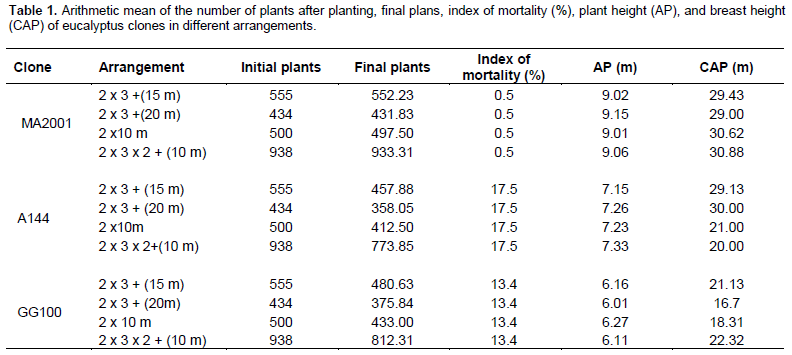
The average height of eucalyptus in different arrangements was 7.48 m after 24 months. According to Peng et al. (2009), the tree height creates striking effects on crop. The greater the plant height is, the greater the competition for water, light and nutrients between crops. However, the competition may decrease when the distance between the rows of trees is larger. According to the author, the spacing between 15 to 20 m makes it a much more valuable route for the use of the culture in agroforestry system. By analyzing the A144 clone, there were no significant differences between the evaluation sites as a function of the arrangements: 2 × 3 m + (15 m), 2 × 3 m + (20 m), 2 × 10 m and 2 × 3 × 2 m + (10 m).
The GG100 clone did not reveal significant differences between the locals of assessment and arrangements of 2 × 3 m + (15 m) m and 2 × 3 × 2 m + (10 m), however, the other arrangements on the north side and center produced higher plants. This is partly because the GG 100 clone average height was 6.14 m, which less influenced the interception of solar radiation when comparing to MA 2001 with an average height of 9.06 m, having higher plants in central and north side. During sowing of sorghum the average eucalyptus height, regardless of clones, was 7.48 m after 24 months. Thus, it is important to know the range of average eucalyptus shadow to deploy planning in agroforestry system, considering that the choice of spacing between the rows of eucalyptus and the crop becomes a factor of production for better absorption of solar radiation in months after sowing, as well as dry matter accumulation and production of sorghum grain. The interaction between eucalyptus and sorghum possibly occurred due to mortality of eucalyptus plants near the sorghum plots triggering less competition between the plants
According to Clemente et al. (2015) the amount of solar radiation reaching among the eucalyptus ranks is crucial to the growth of sorghum in agroforestry system. The amount of light reaching may influence on the agronomic characteristics of the crop. So, the sorghum that is closer to the ranks of eucalyptus has lower height. According to the author, the central plants had a higher height, and this generates higher photosynthetic rate and redistribution of assimilates.
The same was observed by Macedo et al. (2006), who found plant height and weight of corn cob ​​values above the average when the distance between the rows of eucalyptus was between 4.5 to 5.4 m. The average plant height, average weight of corn cob and grain yield were lower for the distances of 1.8 to 2.7 m, possibly because there was influence of incident light in the middle of alleys of eucalyptus clones, oriented east-west. There was a significant effect of all treatments on plant height. Regarding grain yield and effective grain yield, only the interaction of arrangement × assessed site provided no effect on agronomic evaluations (Table 2). These finding were agreed with Clemente et al. (2015) and Gnanglè et al. (2013).
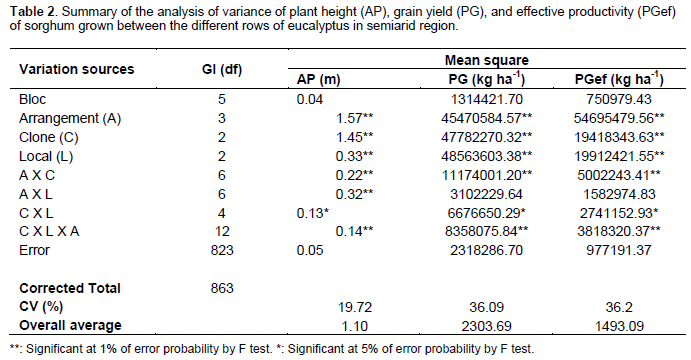
The height of the BRS 655 sorghum hybrid can reach 2.50 m (Rodrigues et al., 2008), which demonstrates that the average height of 1.10 m found in the experiment was influenced by the shading of the culture. The sorghum plant possesses C4 metabolism, therefore, it needs high solar radiation to express its productive potential. The lack of easily available water in soil was also a factor that affected the physiology of sorghum regarding growth. The MA 2001 clone affected the heights of the plants depending on the place of evaluation and arrangement (Table 3). When evaluation was performed in the center, higher plants were observed in most arrangements. However, the assessment in the center did not differ statistically from the assessment carried out on the north side in the 2 × 3 m + (15 m) arrangement. In addition, the north side provided higher yield except of the treatment of 2 × 3 × 2 m + (10 m) arrangement (Table 3).
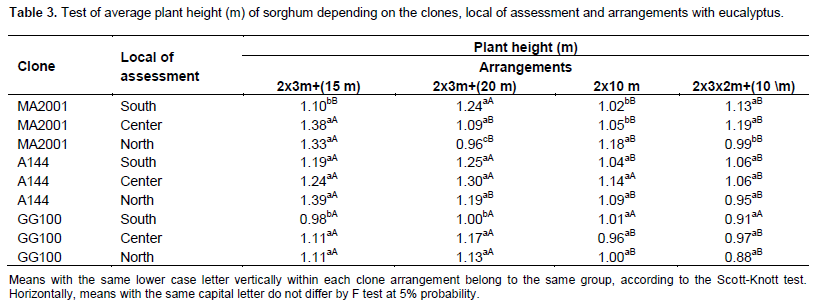
Regarding the arrangements within each assessment site, taller plants were observed for the MA 2001 clone in the 2 × 3 m + (20 m) arrangement measured on the south side and in the center, while north side produced higher plants observed in the 2 × 3 m + (15 m) arrangement (Table 3). The south side with the 144 clone produced higher plants in the 2 × 3 m + (15 m) and 2 × 3 m + (20 m) arrangements, in the center the 2 × 3 × 2 m + (10 m) arrangement produced lower plants with this clone (Table 3).
Regarding the third clone (GG100) the center and north side showed similar behavior having higher plants in the 2 × 3 m + (15 m) and 2 × 3 m + (20 m) arrangements, unlike the north side where plants had the same height (Tables 3 and 4). Importantly, in most places of evaluation on the plots, the 2 × 3 + (15 m) and 2 × 3 m + (20 m) arrangements showed higher plants regardless of the clone (Table 3). The sorghum crop evaluated on the south side with the MA 2001 clone in the 2 × 3 + (20) arrangement had higher plants, probably due to greater spacing between the rows of eucalyptus - 20 m, which provided higher incidence of radiation (Table 3).
The south side with the 144 clone presented higher plants because of higher mortality of the trees in the experiment, which contributed to increased sunlight and less competition between crops. (Table 3). The evaluations in the center showed higher sorghum plants in most arrangements. This may have happened due to lower competition with eucalyptus for water and nutrients from soil or even due to passing diffused light enabling plant photosystems (Table 4). Sowing of sorghum took place during the summer solstice, when the direction of the Sun was east-southeast – west-northwest according the 83,75º azimuth. Over the months was observed the average width of the shadow of 6.2 m as shown in Table 4. Thus, the nearest sorghum lines to eucalyptus rows were shaded more. The north side of sorghum parcel was less affected by shading because the shadow was projected in the same direction of the Sun; however, the opposite side of the parcel was affected by the shadow.

Considering the distance of eucalyptus from sorghum of 1.0 m, width of the parcel of 4.8 m and the length of the shadow of 3.53 m, the two lines of the north parcel of sorghum were not affected by shadowing. Still, the center lines did not show significant difference from the north lines based on height and sorghum productivity. This was probably because of the scattered light passing through the eucalyptus canopy. By analyzing the results of calculated grain yield of sorghum (kg ha-1), regarding different clones, locals of evaluation and eucalyptus arrangements we found with the MA 2001 clone that the assessment site had an effect in the 2 × 10 m and 2 × 3 × 2 m + (10 m) arrangements (Table 5). In this case, lower values ​​were observed when the plots were evaluated on the south and north side of the 2 x 10 m single-row arrangement, and on the north side of the 2 × 3 × 2 m + (10 m) arrangement with triple rows. For the arrangements of 2 × 3 m + (15 m) and 2 × 3 m + (20 m) the evaluation sites did not affect grain yield.
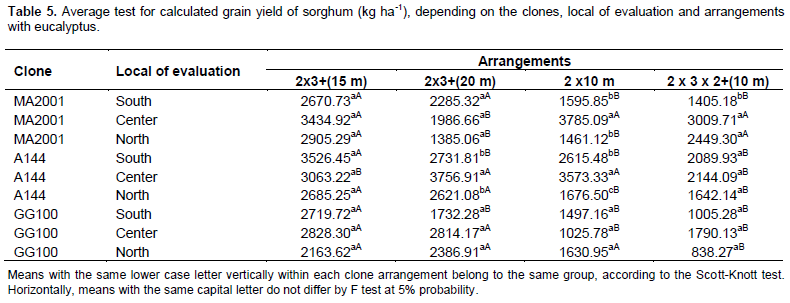
Regarding the A144 clone, we found in the 2 × 3 m + (20 m) and 2 × 10 m arrangements that sorghum yields were reduced approaching the trees with central portion having higher yields. In other arrangements there was no effect of local assessment on productivity of sorghum (Table 4). Table 5 also shows that the grain yield on the south side with the MA 2001 clone was higher in the 2 × 3 m + (15 m) and 2 × 3 m + (20 m) arrangements; in the center in the 2 × 3 m + (15 m), 2 × 10 m and 2 × 3 × 2 m + (10 m) arrangements; and north side in the 2 × 3 m + (15 m) and 2 × 3 × 2 m + (10 m) arrangements. Regarding the A144 clone, the south side of the 2 × 3 m + (15 m) arrangement; the center in the 2 × 3 m + (20 m) and 2 × 10 m and the north side in 2 × 3 + (15 m) arrangements produced higher yield. Finally, the GG 100 clone produced higher yields on the south side in the 2 × 3 m + (15 m) arrangement; center in the 2 × 3 m + (15 m) and 2 × 3 m + (20 m) arrangements; and north in the 2 × 10 arrangement. The effective grain yield with different clones according to the locations of evaluation and arrangements are shown in Table 6. All clones, regardless of the site of assessment, in the 2 × 3 + × 2 m (10 m) arrangement showed the lowest effective productivity, as it was expected because of bigger number of trees.
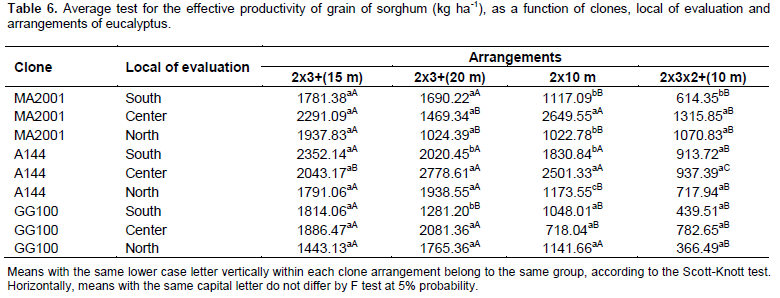
According to the Ministry of Agriculture (Brasil, 2015), the average productivity of sorghum in the northern region of Minas Gerais reaches 1891 kg ha-1. The average effective yield of sorghum in agroforestry system was below when compared to the average productivity in this region. The competition for water, nutrients and light most likely caused low productivity of the crop. However, the effective productivity of sorghum in the 2 × 3 + (15 m) and 2 × 3 + (20 m) arrangements generated high and productive plants (Tables 5 and 6). When comparing the evaluation sites in each arrangement, the same trend of grain yield was observed for effective grain yield. It shows that the sorghum plants which are closer to the clones have smaller effective yield. Therefore, it is recommended that plots involving sorghum intercropped with eucalyptus are well planned for better representation of the environment.
The planning of deployment of sorghum crop in agroforestry system must be made considering the average range of eucalyptus shadow, a greater spacing between the rows of trees and their distance to the crop. The height and effective yield of sorghum were higher in central and north lines of the plot. The 2 × 3 + (15 m) and 2 × + 3 (20 m) arrangements of eucalyptus generated higher sorghum plants regardless of the clone.
The authors have not declared any conflict of interests.
The authors thank FAPEMIG, CNPq and CAPES for their financial support.
REFERENCES
|
Albuquerque CJB, Von Pinho RG, Rodrigues JAS; Brant RS (2011). Row spacing and sowing density of forage sorghum in the northern region of Minas Gerais. Ciênc. Agrotec. 35(3):494-501.
Crossref
|
|
|
|
Argenta G, Silva PRF, Sangoi L (2001). Maize plant arrangement: analysis of the state of the art. Ciênc. Rural Santa Maria 31(6):1075-1084.
Crossref
|
|
|
|
Brasil (2015). Sorgo. Subsecretaria do Agronegócio, Belo Horizonte.
View
|
|
|
|
Clemente MA, Zandondi CHS, Lana RMQ, Franco FO, Albuquerque CJB (2015). Agricultural characteristics and evaluation locations of sorghum plots with different eucalyptus arrangements. Afr. J. Agric. Res. 10(32):3093-3100.
Crossref
|
|
|
|
Coelho MA, Waquil JM, Karam D, Casela CR, Ribas, PM (2002). Seja doutor do seu sorgo. Potafós, (Arquivo do agrônomo, 14), Piracicaba. Available at: http://brasil.ipni.net/article/BRS-3150
|
|
|
|
Gnanglè CP, Gbemavo C, Aïhou K, Kakaï RG, Sokpon N (2013). Productivity of cotton and sorghum in an agroforestry system of shea trees (Vitellaria paradoxa gaertn) in northern Benin. Nat. Sci. 5(2): 207-213.
|
|
|
|
Macedo RLG, Bezerra RG, Venturin N, Vale RS, Oliveira, TK (2006). Silvicultural performance of eucalyptus clones and agronomic characteristic of corn planted in agroforestry systems. Rev. Árvore Viçosa 30(5):701-709.
|
|
|
|
Neto MMG, Viana MCM, Alvarenga RC, Santos EA, Simão EP, Campanha MM (2014). Crop-livestock-forest integration systems in Minas Gerais. B. Ind. Anim. Nova Odessa 71(2):183-191.
Crossref
|
|
|
|
Peng X, Zhang Y, Cai J (2009). Photosynthesis, growth and yield of soybean and maize in a tree-based agroforestry intercropping system on the Loess Plateau. Agrofor. Syst. 76:569-577.
Crossref
|
|
|
|
Rodrigues JAS, Santos FG, Ferreira AS, Casela CR, Tardin FD (2008). BRS 655 - Híbrido de sorgo forrageiro para produção de silagem de alta qualidade. Circular Técnica. Embrapa, Sete Lagoas-MG, Dezembro, 2008.
View
|
|
|
|
Santos RD, Pereira LGR, Neves ALA, Rodrigues JAS, Costa, CTF, Oliveira, GF (2013). Agronomic characteristics of forage sorghum cultivars for silage production in the lower middle San Francisco Valley. Acta Scientiarum, Animal Sciences. Maringá 35(1):13-19.
|
|
|
|
Santos MV, Silva DV, Fonseca DM, Reis MR, Ferreira LR, Neto SNO, Oliveira FLR (2015). Productive components of maize under different weed management systems and planting arrangements in agrosilvopasture system; Ciênc. Rural, Santa Maria 45(9):1545-1550.
Crossref
|
|
|
|
Toma RS, Cooper M, Tavares MF, Carvalho CC, Teato AC (2013). Temporal evolution of soil hydro-physical behavior of an agroforestry system on Ribeira Valley – SP. Sci. For. Piracicaba 41(98):237-248.
|
|
|
|
Zahid DM, Shah FUR, Majeed A (2010). Planting eucalyptus camaldulensis in arid Environment - is it useful species under Water deficit system?. Pak. J. Bot. 42(3):1733-1744.
|